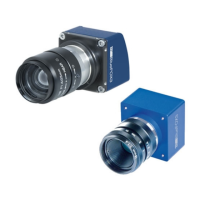18.4.2.1 Basics
To dim a laser line generator, for example, you have to generate a pulse width modulation (PWM).
For this, you will need
2 timers and•
the active signal of the second timer at an output line•
18.4.2.2 Programming the pulse width modulation
You will need two timers and you have to set a trigger.
Timer1 defines the interval between two triggers.•
Timer2 generates the trigger pulse at the end of Timer1.•
The following sample shows a trigger
which is generated every second and•
the pulse width is 10 ms:•
#include <mvIMPACT_CPP/mvIMPACT_acquire.h>
#include <mvIMPACT_CPP/mvIMPACT_acquire_GenICam.h>
...
// Master: Set timers to trig image: Start after queue is filled
GenICam::CounterAndTimerControl catcMaster(pDev);
catcMaster.timerSelector.writeS( "Timer1" );
catcMaster.timerDelay.write( 0. );
catcMaster.timerDuration.write( 1000000. );
catcMaster.timerTriggerSource.writeS( "Timer1End" );
catcMaster.timerSelector.writeS( "Timer2" );
catcMaster.timerDelay.write( 0. );
catcMaster.timerDuration.write( 10000. );
catcMaster.timerTriggerSource.writeS( "Timer1End" );
See also:
Counter And Timer Control
Note:
Make sure the Timer1 interval must be larger than the processing time. Otherwise, the
images are lost.
Now, the two timers will work like the following figure illustrates, which means
Timer1 is the trigger event and•
Timer2 the trigger pulse width:•
18 Use cases
208

